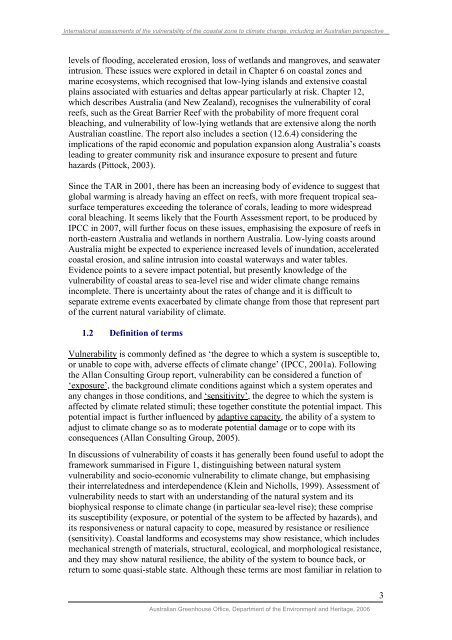International assessments of the vulnerability.pdf - Climate ...
International assessments of the vulnerability.pdf - Climate ...
International assessments of the vulnerability.pdf - Climate ...
You also want an ePaper? Increase the reach of your titles
YUMPU automatically turns print PDFs into web optimized ePapers that Google loves.
<strong>International</strong> <strong>assessments</strong> <strong>of</strong> <strong>the</strong> <strong>vulnerability</strong> <strong>of</strong> <strong>the</strong> coastal zone to climate change, including an Australian perspective<br />
levels <strong>of</strong> flooding, accelerated erosion, loss <strong>of</strong> wetlands and mangroves, and seawater<br />
intrusion. These issues were explored in detail in Chapter 6 on coastal zones and<br />
marine ecosystems, which recognised that low-lying islands and extensive coastal<br />
plains associated with estuaries and deltas appear particularly at risk. Chapter 12,<br />
which describes Australia (and New Zealand), recognises <strong>the</strong> <strong>vulnerability</strong> <strong>of</strong> coral<br />
reefs, such as <strong>the</strong> Great Barrier Reef with <strong>the</strong> probability <strong>of</strong> more frequent coral<br />
bleaching, and <strong>vulnerability</strong> <strong>of</strong> low-lying wetlands that are extensive along <strong>the</strong> north<br />
Australian coastline. The report also includes a section (12.6.4) considering <strong>the</strong><br />
implications <strong>of</strong> <strong>the</strong> rapid economic and population expansion along Australia’s coasts<br />
leading to greater community risk and insurance exposure to present and future<br />
hazards (Pittock, 2003).<br />
Since <strong>the</strong> TAR in 2001, <strong>the</strong>re has been an increasing body <strong>of</strong> evidence to suggest that<br />
global warming is already having an effect on reefs, with more frequent tropical seasurface<br />
temperatures exceeding <strong>the</strong> tolerance <strong>of</strong> corals, leading to more widespread<br />
coral bleaching. It seems likely that <strong>the</strong> Fourth Assessment report, to be produced by<br />
IPCC in 2007, will fur<strong>the</strong>r focus on <strong>the</strong>se issues, emphasising <strong>the</strong> exposure <strong>of</strong> reefs in<br />
north-eastern Australia and wetlands in nor<strong>the</strong>rn Australia. Low-lying coasts around<br />
Australia might be expected to experience increased levels <strong>of</strong> inundation, accelerated<br />
coastal erosion, and saline intrusion into coastal waterways and water tables.<br />
Evidence points to a severe impact potential, but presently knowledge <strong>of</strong> <strong>the</strong><br />
<strong>vulnerability</strong> <strong>of</strong> coastal areas to sea-level rise and wider climate change remains<br />
incomplete. There is uncertainty about <strong>the</strong> rates <strong>of</strong> change and it is difficult to<br />
separate extreme events exacerbated by climate change from those that represent part<br />
<strong>of</strong> <strong>the</strong> current natural variability <strong>of</strong> climate.<br />
1.2 Definition <strong>of</strong> terms<br />
Vulnerability is commonly defined as ‘<strong>the</strong> degree to which a system is susceptible to,<br />
or unable to cope with, adverse effects <strong>of</strong> climate change’ (IPCC, 2001a). Following<br />
<strong>the</strong> Allan Consulting Group report, <strong>vulnerability</strong> can be considered a function <strong>of</strong><br />
‘exposure’, <strong>the</strong> background climate conditions against which a system operates and<br />
any changes in those conditions, and ‘sensitivity’, <strong>the</strong> degree to which <strong>the</strong> system is<br />
affected by climate related stimuli; <strong>the</strong>se toge<strong>the</strong>r constitute <strong>the</strong> potential impact. This<br />
potential impact is fur<strong>the</strong>r influenced by adaptive capacity, <strong>the</strong> ability <strong>of</strong> a system to<br />
adjust to climate change so as to moderate potential damage or to cope with its<br />
consequences (Allan Consulting Group, 2005).<br />
In discussions <strong>of</strong> <strong>vulnerability</strong> <strong>of</strong> coasts it has generally been found useful to adopt <strong>the</strong><br />
framework summarised in Figure 1, distinguishing between natural system<br />
<strong>vulnerability</strong> and socio-economic <strong>vulnerability</strong> to climate change, but emphasising<br />
<strong>the</strong>ir interrelatedness and interdependence (Klein and Nicholls, 1999). Assessment <strong>of</strong><br />
<strong>vulnerability</strong> needs to start with an understanding <strong>of</strong> <strong>the</strong> natural system and its<br />
biophysical response to climate change (in particular sea-level rise); <strong>the</strong>se comprise<br />
its susceptibility (exposure, or potential <strong>of</strong> <strong>the</strong> system to be affected by hazards), and<br />
its responsiveness or natural capacity to cope, measured by resistance or resilience<br />
(sensitivity). Coastal landforms and ecosystems may show resistance, which includes<br />
mechanical strength <strong>of</strong> materials, structural, ecological, and morphological resistance,<br />
and <strong>the</strong>y may show natural resilience, <strong>the</strong> ability <strong>of</strong> <strong>the</strong> system to bounce back, or<br />
return to some quasi-stable state. Although <strong>the</strong>se terms are most familiar in relation to<br />
Australian Greenhouse Office, Department <strong>of</strong> <strong>the</strong> Environment and Heritage, 2006<br />
3

















